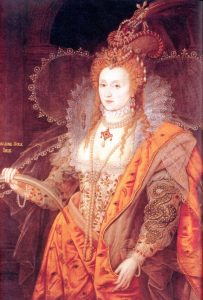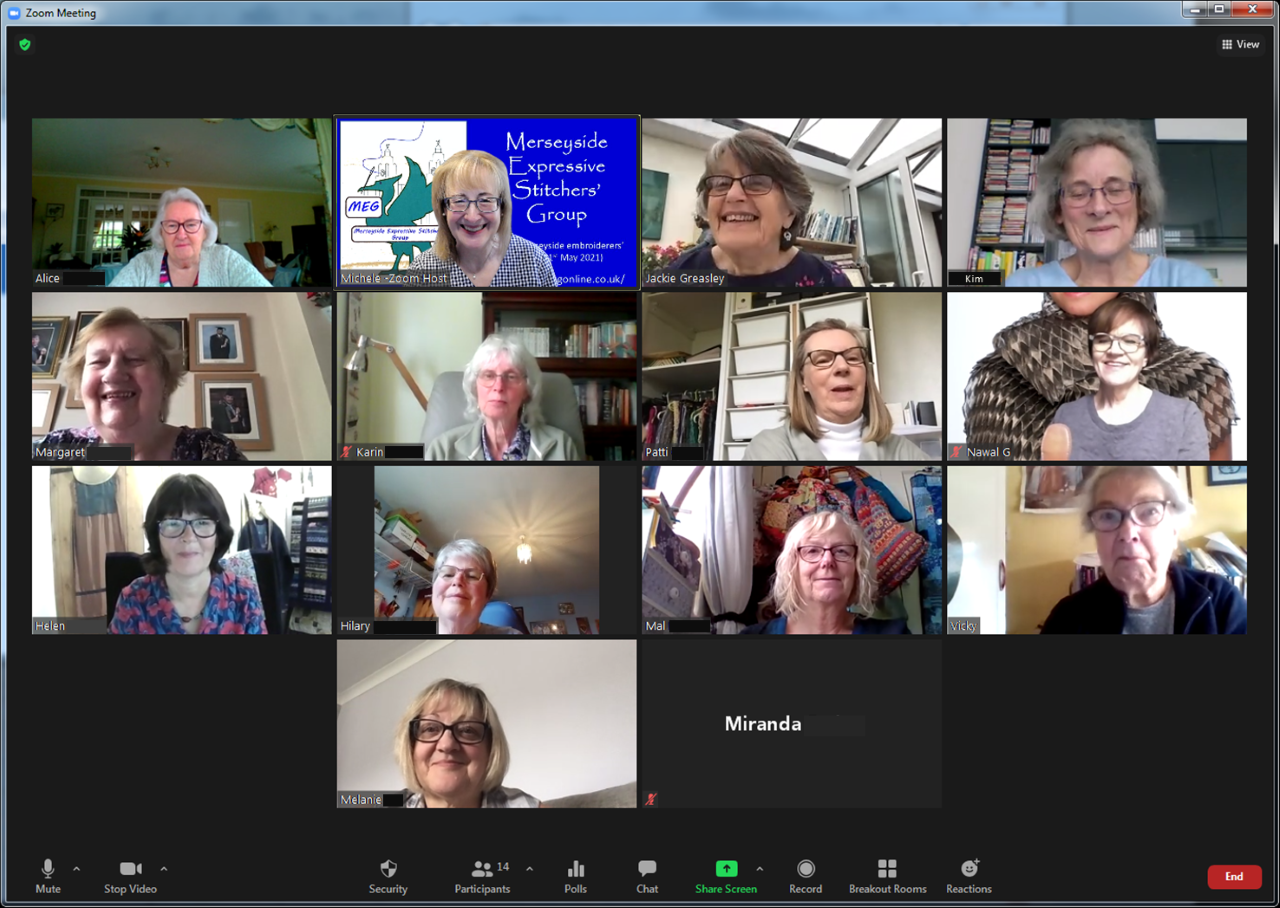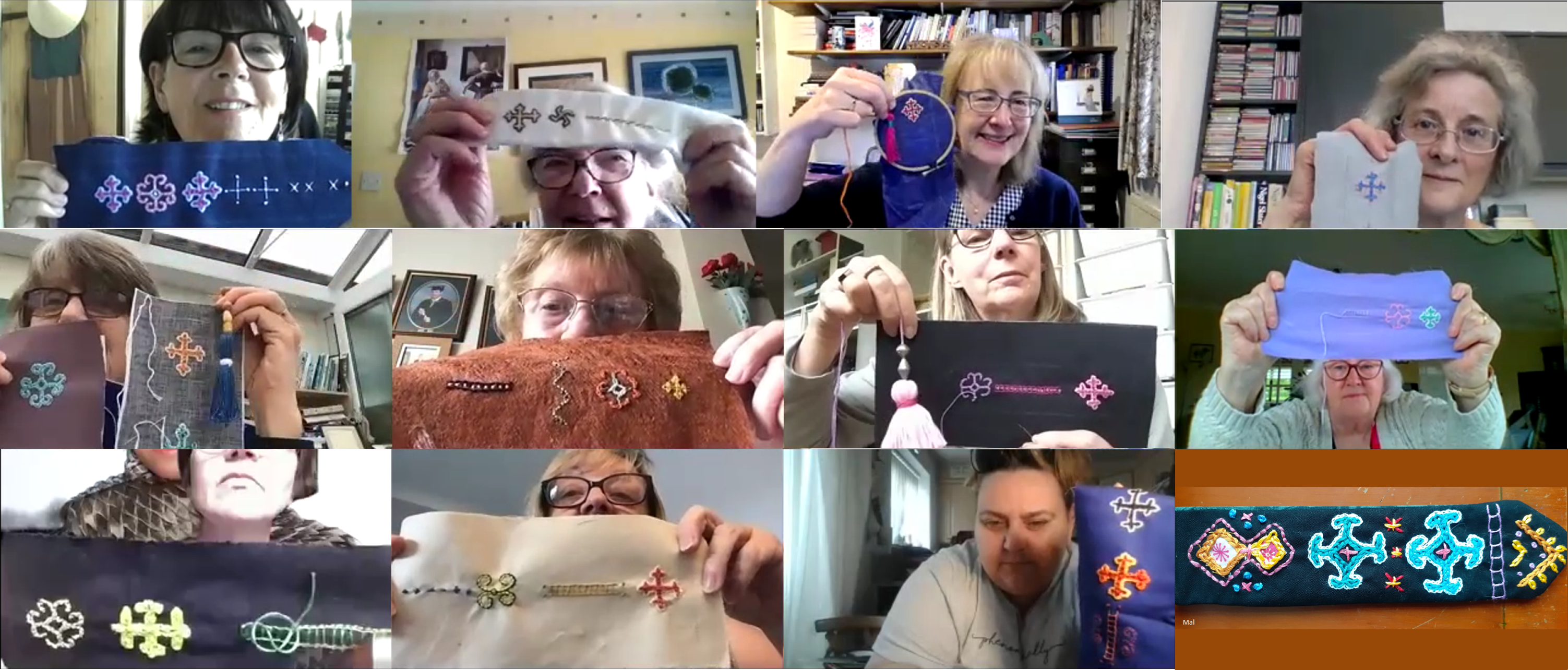November 2021 WORKSHOP by Elizabeth Almond “Sacred Geometry” (report by Eileen Sampson)
MEsG welcomed Liz Almond to All Hallows’ on Saturday 20th November 2021 for a workshop on Sacred Geometry interpreted via Blackwork stitching.
Liz is no stranger to our members, she and her lovely husband quite literally arrived with everything as she said “including the kitchen sink”, but she then proceeded to tell us the workshop on Sacred Geometry had been inspired by a cauliflower and that we were all guinea pigs! Well with an intro like that we knew we were in for a treat, and we weren’t disappointed.
There were many beautiful examples of Liz’s work on display for us all to admire and be inspired by, but every now and then she would bring out another larger piece to talk about and our admiration would just go up another notch, she is a truly talented artist, mind you when we realised the speed with which some were produced, we were all left feeling woefully deflated at our own efforts.
Liz has travelled extensively and has seen so many different examples of sacred designs from very differing cultures around the world. She explained that the geometry of man is so often inspired by the geometry of nature but when we adapt it, it often becomes sacred and worshipped. The designs become part of a people’s religion or social culture and are seen in their art, their jewellery, their clothing, both formal and everyday, even in simple household items. The common factor worldwide though is that they represent designs and shapes that are precious to their respective cultures and hold the same depth of meaning whether they are worked by highly skilled artists for elaborate palaces or by people scratching a living making simple trinkets for tourists.
Liz has taken this same premise and worked differing examples from around the world into an amazing series of embroideries. The complexity and variety ranged from the simplicity of interlocking circles so often seen in Celtic art to a mosque so detailed and elaborate it could almost be a photograph. But at the heart of each design is a starting point of a simple circle, square or triangle which can be added to with infinite detail or left in its purest form. Every design Liz does is worked with a fundamental approach to using basic and traditional hand embroidery stitches. The stitching should mean something personal to the stitcher though and make them think and expand their horizons.
With Liz’s patience, wonderful tuition and depth of practical knowledge we all embraced that thinking and it soon became apparent that, even though we were all working on only a few designs, the variety of the work produced as we each interpreted the design in our own way was incredibly different. This is truly a class for anyone from novice to expert. There are designs that can be done in a day to others that could almost represent a lifetimes work. Liz succeeded in inspiring us to look past the simple shape or the pattern and think how we could add to that with our choices of stitch, texture and colour, be it simply or in great detail. Nothing was too much trouble for her to demonstrate and her practical tips were brilliant but so simple. We all had times of “now why didn’t I think of that?!”. On a personal note, mastering a colonial knot in only 5 minutes of her instructions, when a French one took me donkey’s years to get the hang of, was definitely a highlight of the day!
Thank you Liz for a thoroughly enjoyable, informative and interesting day. Your designs were a joy to behold and you were a joy to work with. On behalf of all MEsG members, we might be a new group but you are definitely an old friend, come back soon.
October 2021 TALK by Nawal Gebreel “Textiles of Afghanistan” (report by Vicky Williams)
Nawal, a member of the Merseyside Expressive Embroiderer’s Group, gave us an enlightening talk on her visit to Afghanistan and her collection of clothing and other decorated items. It was fascinating to see the designs used in villages separated by the mountainous country. There were some similarities in colour due to the same basic materials being collected and used. Male costumes seemed to have the most decoration.
Nawal obviously became very attached to some of the people she showed wearing the traditional costumes. She recounted how she was taught the stitches and designs, having many samples for us to examine. She also had a design scrapbook reflecting her interest in the embroideries. It was lovely to handle the garments and even try on the beautifully decorated hats.
A country that now seems to be an area of conflict came a little nearer to us, showing that people still make and appreciate careful handwork and tradition.
September 2021 WORKSHOP with Judith Rowley “Beautiful Surfaces: From the Traditional to the Contemporary” (report by Maggie Pearson, photographs by Maggie Pearson and Nawal Gebreel)
Judith Rowley is a talented and renowned textile artist who exhibits regularly with Prism Textile group. Twelve of us attended Judith’s workshop on September 18th, which focused on the manipulation through stitch of turban cotton (which is fabulously soft when washed), to create beautiful shapes which could form 3D pieces.
The potential of applying paints/dyes and embellishing the initial manipulated pieces with silk, felt and other fabric scraps was explored. Judith’s books of samples demonstrated how this technique can be applied to create beautiful and varied pieces.
We were also delighted to welcome a new member to our group.
July 2021 ZOOM WORKSHOP with Maggie Pearson “Natural Dyes and Botanical Printing” (report by Pat McBride, photographs by Michele King via Zoom)
We had a very productive workshop with Maggie where we learnt a great deal and dyed some lovely scarves and fabric. We also had a lot of fun and really enjoyed the day.
Maggie explained the science behind botanical printing and demonstrated clearly how to make onion dye. We then created shapes, lines, circles etc Batik style before dyeing our scarves. The was excitement all round as we shared our results.
In the afternoon we learnt how to print on linen and cotton with the leaves we had collected. Again Maggie explained clearly the reason the leaves printed and showed us how to do it. Many thanks to Maggie for an interesting and enjoyable day. As one of us said “This could become really addictive!”
June 2021 ZOOM TALK with Lois Wilkes “Rummaging in a Queen’s Wardrobe” (report by Kim Parkman)
Lois Wilkes, the secretary of Ashbourne Creative Stitchers, gave a fascinating talk about the clothing of Queen Elizabeth 1. Although little remains of the actual clothing, Lois used court records, portraits and contemporary accounts to reconstruct the wardrobe of a woman who loved clothes and understood their ability to convey messages through colour and symbolism. Elizabeth wrote that ‘princes are set on stages…a spot is soon spied in our garments’. A glance at the newspapers today would confirm that this is still true for the current royal family.
For those of us worried about our bulging wardrobes, it was heartening to hear that Elizabeth owned more than two thousand dresses. She spent large sums of money on keeping up with the latest fashions, although this paled into insignificance compared to the spend-thrift Stuarts who succeeded her. The upkeep of such a wardrobe was very labour-intensive, and a small team was permanently employed keeping her linen white, waging war on pests and repairing and remodelling her garments. Upcycling is not a new phenomenon, and Elizabeth even used her father’s jewels to add splendour to the skirt of a gown.
As she was laced and pinned into her outfits each day, constantly watched and aware of the image that she would project, it must have been an isolated life, with no privacy even when getting ready. It was also a fearful one, with the queen, who was excommunicated by the Catholic Church, under threat of assassination. Even her clothes might contain a deadly substance that could end her life. We were given a glimpse of her difficult relationships with her courtiers and her cousin, Mary, Queen of Scots. Mary herself realised the power of embroidery to send messages of subversion or political statement. Elizabeth’s dress covered in eyes and ears (as seen in the Rainbow Portrait) was a reminder to all of both her power and the all-seeing nature of her extensive spy network.
When Elizabeth died her clothes were remodelled to suit the new Stuart dynasty or was given to courtiers. A final link to the glorious wardrobe of this long-reigning monarch has only recently been rediscovered, converted to an altar cloth in the church at Bacton, but her sense of drama and political wisdom lives on in the portraits of Elizabeth that were painted throughout her life.

portrait of Elizabeth 1 is in the collection of the Marquess of Salisbury, Hatfield House, Hertfordshire
May 2021 ZOOM TALK and WORKSHOP with Helen Barnes “Vietnamese Patterns” (report by Vicky Williams, photographs by Michele King via Zoom)
 True to their words to take us travelling, Kim and Alice gave us another country to enjoy and drool over the textiles produced by local people. Vietnam is a long narrow country with 54 ethnic groups and there appear to be various styles of embroidery. The highland country seems to be the area where most stitching and weaving occurs. Near the Thai border silk shading is taught, with a 2year apprenticeship; simple but effective stitching is taught. Buddhist Temples show a strong Chinese influence, with plenty of dragons in sight. There is a Museum of Ethnology, which reminded our tutor Helen Barnes of an eastern version of Beamish! Here were shown costumes with embroidered facing bands on coats and head dresses. Many costumes were woven from hemp although modern materials are being used. Women wear highly embroidered clothing in yellow/white/red colours, with batik also used. Cross stitch seemed to be a popular choice, also appliqué.
True to their words to take us travelling, Kim and Alice gave us another country to enjoy and drool over the textiles produced by local people. Vietnam is a long narrow country with 54 ethnic groups and there appear to be various styles of embroidery. The highland country seems to be the area where most stitching and weaving occurs. Near the Thai border silk shading is taught, with a 2year apprenticeship; simple but effective stitching is taught. Buddhist Temples show a strong Chinese influence, with plenty of dragons in sight. There is a Museum of Ethnology, which reminded our tutor Helen Barnes of an eastern version of Beamish! Here were shown costumes with embroidered facing bands on coats and head dresses. Many costumes were woven from hemp although modern materials are being used. Women wear highly embroidered clothing in yellow/white/red colours, with batik also used. Cross stitch seemed to be a popular choice, also appliqué.
Helen provided members with a sheet of templates and stitch examples prior to class. She demonstrated various stitches and each member chose her own motif, these were repeated down the centre of the sample. Motifs were worked in a slightly chunky thread and then out lined by chain stitch in a thinner thread; this is typical of Vietnamese textiles.
There was much patient instruction for members to learn various stitches; the last part of the afternoon was spent in learning how to make a tassel, for those who had no knowledge. The sample book mark, once having the back covered, could be decorated with a tassel or beads sewn to the lower edge.
April 2021 NORTH WEST REGIONAL DAY by ZOOM hosted by Merseyside branch.
March 2021 ZOOM TALK with Susan Briscoe “Sashiko” (report by Sarah Lowes)
February 2021 ZOOM TALK with Hilary Naghashi “Persian Delights” (report by Mal Ralston)
February’s talk was by Hilary Naghashi who showed us photographs of the Iranian landscape and gave us an insight into Persian textiles. The landscape was wild and beautiful and mainly unchanged for years and, in the current circumstances, it was lovely to see something other than Liverpool! Hilary and her family travelled around in a beaten up car where she had to hold onto the handle to keep the door shut! Family connections gave her greater access to some of the nomadic people,although sometimes she was unable to take photographs.
Some of the people lived in yurts, well insulated with fleeces and decorated with textiles hanging from the roof. They are still able to weave textiles and dye wool with basic equipment out in the countryside. The rug weaving is mainly done by the men, and they have achieved great speed. The quality of the textile can be determined by the number of knots at the back.The motifs on the rugs or textiles are naive and sometimes the number of legs on an animal depend on the available space! The camels are distinctive and all motifs charming. The colours are bright and inviting, though not always light fast. Many textiles are cut from a large roll so any size can be purchased. The vendors seem to be arranged by trade into the streets, for example a street of traders selling tools, followed by a textile street, then perhaps a street of food vendors.
We were also shown photos of recycled textile hangings. These were made from pieces of used tunics sewn together in a patchwork arrangement. Nothing goes to waste.
The buildings were also of interest. Local customs meant restrictions on talk between men and women. Some mothers in law wore scarves across their faces and their sons in law had never heard them speak in many years of living together. Many properties had a double door with a different knocker on each side, one for females to use, the other for males. The different sounds meant that whoever was inside would know whether it was a man or woman at the door and send the appropriate person to answer.
The camels were well decorated with colourful woven bands decorated with metal tassels. Many of these tassels found their way into the markets where they were sold as earrings.
We were shown some slides of the Ali Qapu palace with many fine decorative arches inside. These provided the inspiration for some textile pieces that Hilary had made, and it could be seen that both the architecture and the naive motifs could be used as a starting point for our own work. The textiles were bright and colourful and Hilary’s talk gave us a good insight into Iranian life and was very well received.
January 2021 ZOOM WORKSHOP by Jenny O’Leary “Laminated Tissue” (report by Olive Halsall)
Jenny O’Leary’s Zoom workshop was a great success with many attendees and some from other guilds attending. The session started at 10.00am with a break for lunch then continued 2pm till 4pm.
In the period for lunch we were able to chat with each other- during this lockdown period a bonus. We could either take part in the workshop or watch the carefully planned session.
Tissue paper was the main medium used and Jenny had an array of uses designs which were inspirational. She showed step by step the method she used to dye dilute,tear, and design using stamps etc and how each reacted to different methods. At the end work was shown and each person had a different aspect of the methods used.
Jenny then showed more ways in which we might experiment going on to use this technique and was open to more questions on the workshop .
Thank you Jenny for a lovely day.
Here are some photos from people who attended this workshop. If you would like your photographs to be included here please send them to secretary@megonline.co.uk.
Pat attended the Zoom workshop. She says –
My granddaughter and I made a 3D butterfly out of the papers. Not what I had in mind but she needed a 3D insect for a school project!
Barbara attended the Zoom workshop. She says-
Sorry I’m a bit late with this- I was so busy yesterday.
The first two are the layered tissues. I polished them up a bit with Liquiblend wax that’s not the same as Acrylic Wax but had to do. The dotty pattern on the first one was a carpet rubbing with sennelier oil stick, inside the sandwich. It showed up more opaque than the oil pastels.
The second two photos are single sheets that I also stencilled with Milton and painted with procion dyes and the red one was rollered with a pattern wheel that I’d dipped into wax then sprayed with Milton and also painted. For me, the single sheets are more useful. I do painting in oils with cold wax as well as stitching work, so I can use bits for a last thin collage layer, and use bits backed with Misty fuse for machine stitch work.
I really enjoyed the day. Thanks for organising and spreading it out to other groups. I’m in the Birkenhead group that meet at the Williamson museum and gallery – sadly under threat of closure again.
Sue attended the Zoom workshop. She says-
I really appreciated the invite to the Jenny O’Leary workshop thank you and thoroughly enjoyed the session. I thought it worked extremely well and hope to join in on more of the same if possible. I have included some of my results and hope to use them in sketchbooks and textile work. I am a lapsed member of Preston EG and now I intend to rejoin, so thanks again.





































































